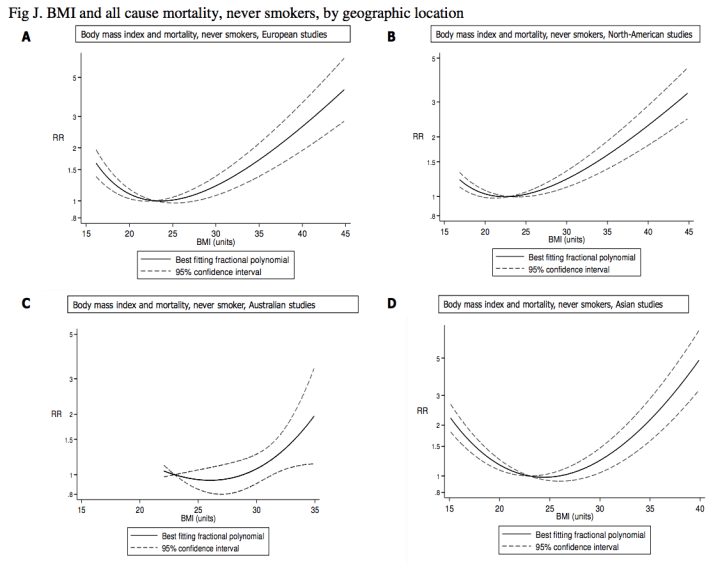This is a collection of plots and data speaking to the relative risk associated with BMI. Generally speaking, while social or other unobserved genetic differences may confound comparisons of absolute risk, comparisons of relative risk seem to show a pretty consistent pattern. Put differently, different groups may have different mortality even conditional on BMI, but within groups (race, education, income, cohorts, countries, etc) the apparent effect on mortality risk appears to be very similar. In terms of log-mortality rates, group differences of this sort seem to operate largely on the intercept as opposed to the slope (excluding age, sex, and current/past smokers).
Best current estimate
Large non-linear (“J”) curve from meta-analysis. This is only for never smokers, which is important, because smoking is associated with weight loss and higher mortality (big confound). It is believed that much of the “U” shape found on the left-side in some older analyses is a mostly product of smoking.
Historical relationships
Broadly similar patterns have been found historically, particularly on the right (overweight+) side. For example, amongst 1.8 million Norwegians at least 15 years of age between 1963 and 1975, we find this mortality curve.

Likewise, in the United States amongst civil war veterans (and not much apparent association with SES then).

Likewise, in New Zealand, amongst a cohort born between 1870 and 1874 (WWI service records).

“The evidence that the shape of this relationship holds in another nineteenth century cohort is significant. If we take seriously the hypothesis that environmental, social and economic conditions can influence health we are also obliged to consider that ‘influence’ is itself a variable. Parameters can shift, and coefficients can change. This evidence from New Zealand suggests that the elevated mortality risk of being overweight in the late nineteenth and early twentieth century could have been broadly similar across developed countries.”
The point with lowest BMI mortality risk in the available historical evidence is generally pretty close to what analyses in much more recent data suggests and the increases in mortality were significant and broadly comparable to what we observe in much more recent data today (even when there’s wasn’t usually a particularly obvious relationship to socioeconomic status). It’s worth keeping in mind that whole BMI distribution has shifted far right over the past several generations throughout the developed world. Where most of the population was generally well within optimal BMI range a few generations ago, that’s clearly not the case in the United States circa 2019 despite the fact that the genetic profile clearly has not changed that much.
International comparison (cross-sectional)

Race/Ethnicity
Likewise, disaggregations by race/ethnicity indicate the relationship is very similar for most groups of interest. This is clearly true for whites and blacks in the United States and in the UK. The curve for east asians seems to be shifted slightly left (higher relative risk in conditional terms), tho this may convergence if viewed as a function of body fat (statistical differences in bone and muscle mass density conditional on height).
Likewise if this is adjusted statistically.
Socioeconomic status

Likewise, although the linear (constant) estimates are far from ideal, they show similar risk estimates when group adjustment is accounted for.
All participants (including current and former smokers)


Never Smokers (typically larger, less confounded effects)
Sex and age

The apparent effects in younger people are generally much larger and more unambiguous.








